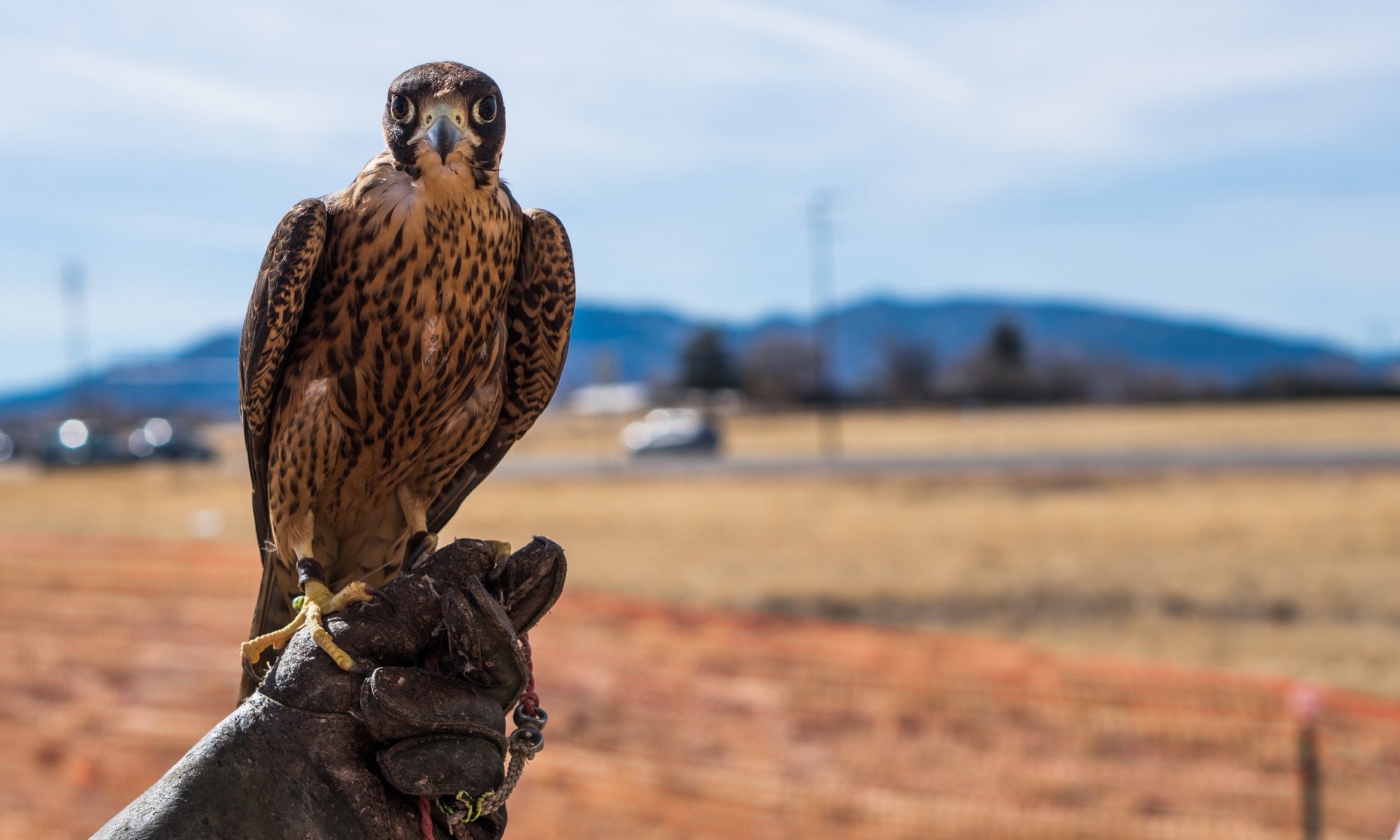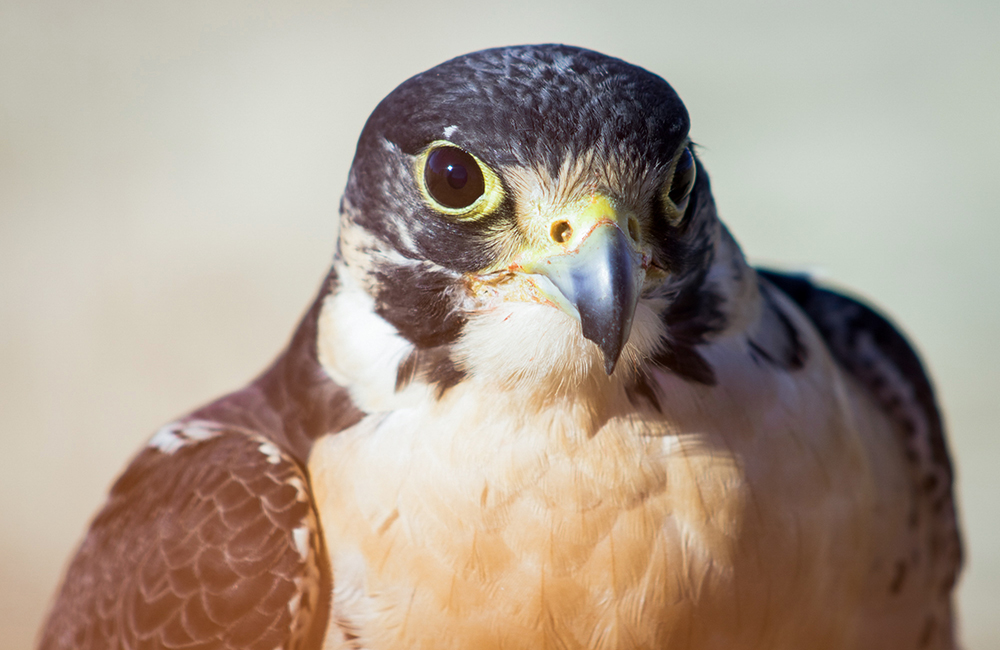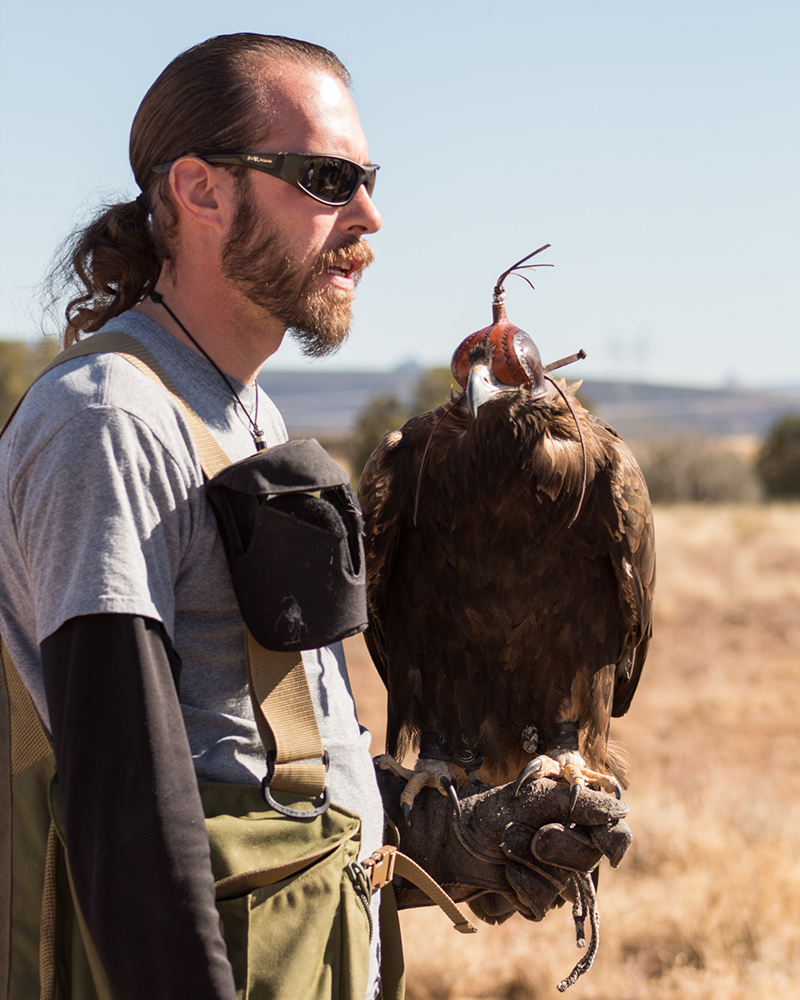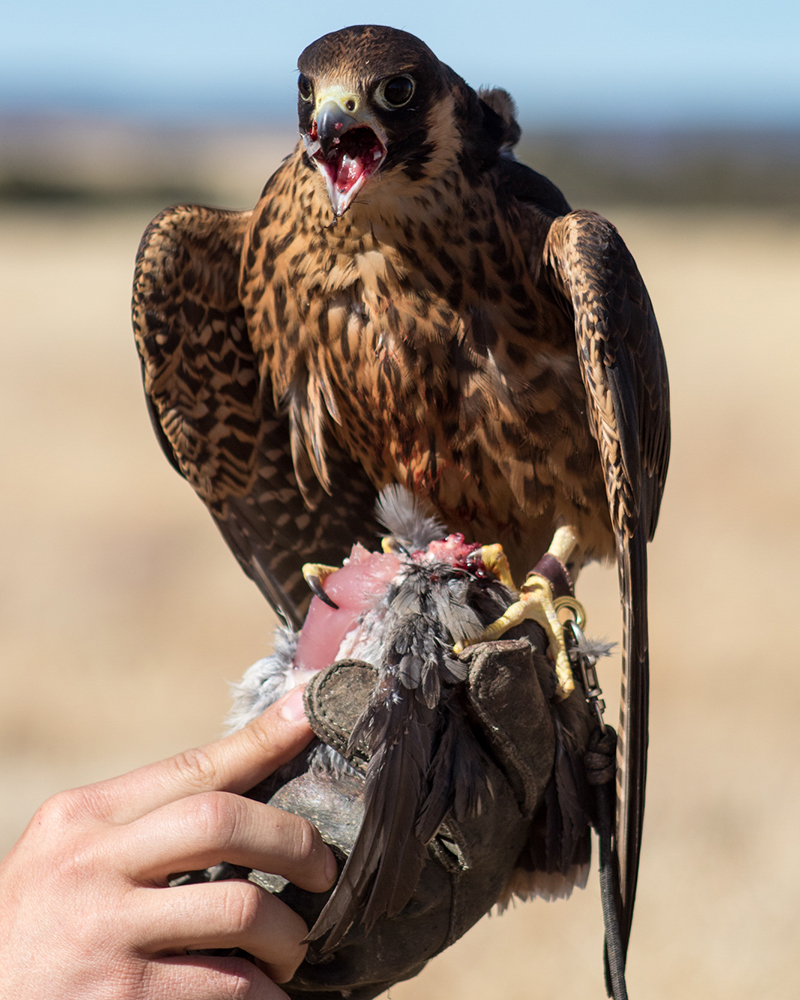
Arizona falconry takes flight in efforts to promote conservation
By Daria Kadovik and Melina Zúñiga/ Cronkite News |
CHINO VALLEY – Joseph Pravongviengkham slips a hood of red kangaroo leather over the head of his falcon, Sully. He wants to keep his bird calm for the 30-minute drive to an open field filled with quail, jackrabbits and cottontails.
When they reach their destination, Pravongviengkham releases Sully from his box, removes the hood and takes the bird off its tether. Sully soars above the small group gathered, spots a pigeon and dives.
“Hey yo!” the crowd shouts.
Pravongviengkham, 21, of Waddell, brought his juvenile Barbary falcon to attend the three-day Arizona Falconers Association Desert Hawking Classic, a gathering of falconers – people who train birds of prey to hunt for sport. He’s happy with Sully’s performance, and the bird gets a reward – the pigeon. But when there is no kill, sometimes the thrill of the chase is reward enough.
Dozens of people from across the nation came to Chino Valley for the January event, hosted by the Arizona Falconers Association. It included speakers, workshops and “game hawking.”
Falconry, which includes training hawks, eagles, falcons and even owls, has grown over the years in the U.S. There’s an estimated 100 licensed falconers in Arizona and roughly 5,000 nationwide, according to the International Association of Falconry and Conservation of Birds of Prey.
The falconers say they not only want to promote an ancient art and care for the birds, they want to ensure the existence of these birds in the future. The groups often support environmental conservation efforts.
But Sarah Preston, the associate director of People for the Ethical Treatment of Animals, or PETA, said falconry involves “terrorizing and killing quail, pheasants and other game birds for pleasure.”
“It’s a blood sport,” she said in a statement. “Whether the raptors used in falconry are captured or bred in captivity, they’re denied everything that’s natural and important to them. They live inside small enclosures and don’t have the opportunity to fly at will, choose a mate or raise their young.”
Falconers promote conservation efforts
Despite such criticism, many falconers defend what they do, saying they help save the birds’ lives.
The mortality rate for the birds of prey in the wild is high, said Charlie Kaiser, president of the Arizona Falconers Association. About 70 percent of these raptors will die in their first year, according to The Modern Apprentice, a falconry website.
If the birds are not good hunters, they will starve, Kaiser said. If they hunt in the wrong area, another predator might kill them. If they hunt too close to a road, a car might hit them.
With the training and conditioning falconers provide, the birds’ chance of survival increases significantly when they’re released back into the wild, Kaiser said. Falconers teach them how to hunt, take them for veterinary care and make sure they eat a well-balanced diet.
Most of the falconers release the birds back into the wild, Pravongviengkham said. But some falconers keep their birds for life.
“We have had our birds for 20 years now,” Kaiser said. “They are our kids. We love them to death.”
Kaiser owns one of the oldest hawks in North America that still hunts, he said. Cowboy, a male captive-bred Harris’s hawk, is 30 years old.
Arizona has many birds of prey commonly used for falconry: the red-tailed hawk, Harris’s hawk, Cooper’s hawk and northern harrier. None is threatened or endangered.
Certified falconers in Arizona can take a limited number of birds from the wild each year, Kaiser said. For example, the state allows only allows the capture of 30 Harris’s hawks each year, with limitations on where and when falconers can collect the birds, according to Arizona Game and Fish.
When it comes to preserving other wildlife, falconers say they pay close attention to what their birds hunt by watching game populations and patterns.
For example, this year’s lack of rain has led to a decline in cottontails and quail.
“We pay attention to all this stuff because we are a part of the environment,” Kaiser said. “We are not just sitting back and watching it on TV.”

Falconers say their sport has saved peregrine falcons, like this one, from extinction. (Photo by Melina Zuniga/Cronkite News)
Acquiring and training birds of prey
There are two ways to acquire a bird for falconry: trap a wild one or purchase a captive-bred bird. Captive-bred birds cost from $200 to more than $10,000, according to howmuchisit.org.
Falconers can only take first-year birds from the wild. Otherwise, Kaiser said, they could interfere with birds who are breeding or trying to feed their young.
“I consider taking a bird from the wild to be a very serious matter,” he said. “You are calling a wild animal out of the sky to be your partner, and that is not something I ever take lightly.”
Falconers use traps with bait to catch wild birds, then start the long process of building trust between a human and a bird.
Training a bird to hunt could take up to a month.
Tucson resident Shane Farrier drove to Chino Valley with his 14-year-old male Harris’s hawk. Farrier said the hardest part about training is “getting them to associate the fact that you’re going to feed them and not kill them.”
Falconers use the hoods to calm the birds because the birds are “so visually oriented that they are not fearful of what they cannot see,” according to the Modern Apprentice.
The trainer offers the bird food from a gloved hand just out of its reach. The purpose is to have the bird jump to the glove, which will train it to return to the falconer during a hunt.
The process continues until the falconer can stand 100 feet away, and the bird flies to the glove.
‘As affectionate as a stone’
It’s not easy to become a falconer. It involves finding a sponsor, taking a comprehensive exam and building a hawk house, which Arizona Game and Fish must inspect before it issues a sport falconry license.
State and federal laws also dictate the levels for care of captive wildlife.
Bostwick said the most important skill involved in falconry is patience. An article called “So, you want to be a falconer” on the Arizona Falconers Association website warns that a falconer must “commit part of your working hours to a creature that will, at the very best of times, merely tolerate your presence and is as affectionate as a stone.”
Falconers connect with one another, and others, over the challenges.
As people drove by the Days Inn hotel in Chino Valley, many stopped to ask questions about an unusual fenced area, called a weathering yard, in front of the hotel where birds of prey could rest after the hunt. Falconers were eager to answer any questions about owning birds of prey, hunting and becoming a falconer. Later, the falconers gathered at the hotel patio and shared their stories over barbecue.
The January event included an apprentice workshop.
Kaiser said one of the beauties of the apprenticeship program is that for the first two years, the apprentice is under the “care and thumb” of somebody who is making sure they are doing the right thing.
Apprentice Jackson McQuerrey, 16, and his father, Shannon, who has been a falconer for more than 10 years, also drove to Chino Valley from their home in Phoenix with Jackson’s 23-day-old red-tail hawk.
Jackson said he hopes to reach the status of master falconer, which requires a two-year apprenticeship, followed by five years as a general falconer. Once a master falconer, you can legally own up to five birds in Arizona.
Jackson said part of the art of falconry involves developing a relationship with the bird.
“If they want to leave, they can. But it’s their choice to come back to you,” Jackson said. “They’re always going to be wild. You want to try getting them as domesticated as possible, and it just becomes a really good partnership.”
Kristy McDonald, another aspiring master falconer, agreed.
“If you come home with your bird, it’s a good day of falconry,” she said.












Leave a Comment
[fbcomments]